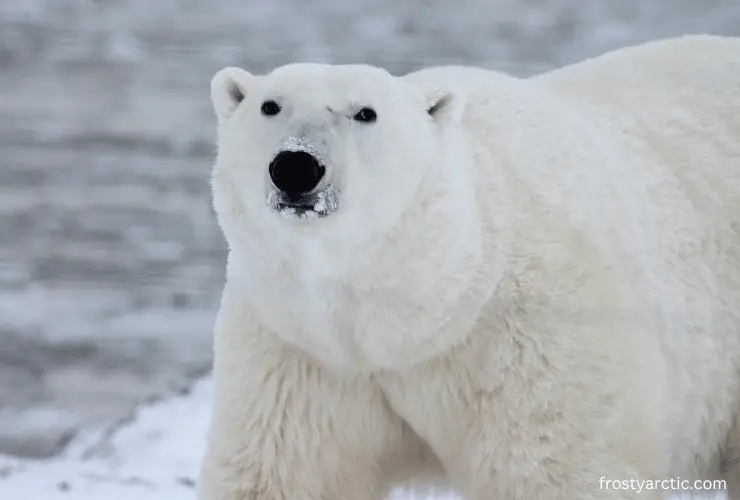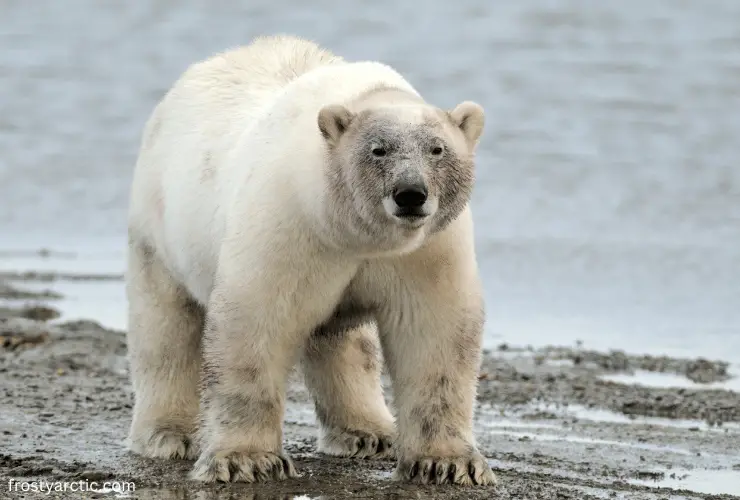Yes, it is technically feasible to consume polar bear flesh. It is, however, strictly discouraged for various reasons, like health issues, ecological impact, and legal issues. If swallowed, Polar bear liver contains hazardous quantities of vitamin A, which can cause major health problems in humans, such as dizziness, nausea, migraines, skin irritation, and even death.
Polar bears are an important species in Arctic ecology. Their extinction might have a huge influence not just on the ecosystem but also on other species that share the same habitat.
Polar bears are protected in several nations because of their vulnerability to climate change and other factors. Hunting, trapping, and killing polar bears without permission can have serious legal consequences. The following article explains all about polar bear meat and its consequences for human life. So, let’s get started.
Can Humans Consume Polar Bear Meat?
The answer is Yes. But humans do not consider polar bears’ meat edible for various reasons.
To begin with, polar bear meat is frequently described as hard and chewy. This is because polar bears are extremely muscular creatures with minimal fat.
Secondly, Polar bears develop a lot of mercury in their systems, which may be harmful to humans if they ingest it. Particularly the polar bear liver.
Thirdly, The United States government declared in May 2008 that hunting polar bears for food is strictly prohibited under the Endangered Species Act, which protects them from the threat of extinction.
Is Polar Bear Meat Poisonous to Humans?

No, consuming polar bear meat does not harm humans, but certain parts of their bodies can cause harm or even death. The high levels of vitamin A in the liver of a polar bear, due to its nutrient-rich diet, can lead to health issues.
Excessive vitamin A consumption in humans can result in hypervitaminosis. Symptoms can range from minor to severe, including dry skin, hair loss, irritation, alterations in eyesight, and bone pain. “Hypervitaminosis A” can cause coma or death in severe situations.
Indigenous peoples that have historically hunted polar bears for a livelihood are usually well aware of the hazards of eating the liver, so they don’t consume it.
To avoid possible risks like this, it’s critical to be aware of safe eating practices for all wildlife species.
Can You Die from Eating Polar Bear Meat?
Polar bear meat may contain various hazards.
When eating polar bear meat, make sure it is thoroughly cooked. Raw meat from bears has a tiny roundworm called trichinella, which may make humans sick. Trichinella cannot be killed by freezing or fermenting meat. It can only be eliminated by cooking at 160°F.
Before eating a polar bear, ensure there is no pink or red flesh. It is important to note that many polar bears are carriers of the trichinella worm, a parasite that causes trichinellosis, also referred to as trichinosis. This disease is caused by the larvae of the trichinella worm and should not be taken lightly.
The worms spread infections as they move through the digestive system. As a result, symptoms such as headaches, fever, sore joints, muscle pains, diarrhea, and in some cases, death, could be experienced.
Has Anyone Died in History Due to Eating Polar Bear Meat?
The issue of polar bear liver poisoning was first discussed by Europeans in 1597.
In his diary, Dutch explorer Gerrit de Veer reported becoming sick while seeking refuge in Nova Zemlya during the winter.
After consuming polar bear liver, he and his companions were very sick. Since that initial story, there have been more stories of polar explorers falling sick and dying after consuming polar bear meat, especially its liver. – ScienceDirect
Do Eskimos Eat Polar Bears?

Yes, Polar bear meat is essential to modern and traditional Eskimo diets. While the meat is savory and tasty, it is also potentially hazardous. Eskimos frequently prefer the meat of animals such as caribou, whales, and walruses. The Inuit rely on polar bear fat as a vital part of their diet.
G. Edgar Folk Jr., an environmental physiologist at the University of Iowa, indicates that polar bears hunt and eat seals, and seal blubber is rich in omega-3 fatty acids obtained by seals from their diet of oily seafood.
Clinical trials involving humans have shown that omega-3 fatty acids can help reduce high levels of cholesterol in the blood, which is a major risk factor for heart disease.
The Inuit have a deep connection with polar bears. They hunt them for survival, study them extensively, and use their fur for clothing and sleeping mats.
What Does a Polar Bear Taste Like?
Polar bear meat’s flavor varies based on factors like hibernation and diet. Spring bears have less fat and eat mostly plants, producing thinner, less intense meat.
However, in the autumn, bears have built up a substantial fat coating in preparation for their future hibernation, making the flesh fattier with layers.
A bear’s diet affects the taste of its flesh. Eating fruits and plants makes it delicious, while consuming dead carcasses and fish gives it a strong scent and savory flavor.
The polar bear’s diet mainly consists of seals, which give its flesh a distinctly gamey flavor that is often more potent than other types of bear meat.
How To Prepare Polar Bear Meat?
Properly cooking bear meat requires a “slower and lower” method, which keeps the meat tender. Also, ensure that any parasites or worms are killed by heating it to a sufficient temperature.
Now, Put the bear meat in the slow cooker and make a bear pot roast with veggies. Seasonings are a terrific way to prepare bear meat. The ultimate result is soft yet firm meat that resembles pot roast or pulled pork.
Nutritional Facts of Polar Bear Meat

Nutritional facts for the serving size of 100 grams
| Calories 130 | Calories from fat 27.9 (21.5%) | % Daily Value |
| Total fat | 3.1g | 4% |
| Saturated fats | 0.6g | 3% |
| Polyunsaturated fats | 0.5g | |
| Monounsaturated fats | 2g | |
| Cholesterol | 0 mg | 0 % |
| Sodium | 0 mg | 0 % |
| Total carbohydrate | 0 g | 0 % |
| Dietary fibre | 0g | 0 % |
| Total sugar | 0 g | 0 % |
| Protein | 26g | 52 % |
| Vitamin D | 0 mcg | 0 % |
| Calcium | 221 mg | 15% |
| Iron | 1.098 mg | 6% |
| Vitamin A | 12600 mcg | 1400 % |
| Vitamin C | 1.8 mg | 2% |
| Thiamine | 0 mg | 0 % |
| Riboflavin | 0.0078 mg | 0 % |
| Niacin | 0.64 mg | 4 % |
Can You Eat Polar Bear Liver?
No, you cannot consume polar bear liver. These animals have developed a technique to store dangerous chemicals such as mercury and other contaminants in their livers due to their Arctic environment. If humans consume them, they may face a health risk.
Furthermore, a polar bear’s liver contains a high percentage of retinol, which can cause human vitamin A toxicity. Consuming any part of a polar bear is illegal in most countries because this species is protected and considered endangered worldwide.
Do People Eat Polar Bears in Alaska?

As documented by the Alaska Department of Fish and Game.
Yes, some people in Alaska do eat polar bears. However, it is important to note that the majority of polar bear hunting is carried out by Native American communities that have been granted permission under the Marine Mammal Protection Act.
People consume polar bear flesh, with a preference for the front and back paws. They typically boil the meat or use it to make stew. The meat must be fully cooked to avoid infections such as trichinosis. Consuming raw or undercooked meat might expose you to this disease.
Polar bear hunting and consumption hold cultural and spiritual meaning for some tribes. Eating meat strengthens community and values while providing sustenance.
However, It is necessary to remember that polar bears are a threatened species, and their hunting is strictly restricted. Their meat is not something you will find at restaurants and supermarkets.
Frequently asked questions (FAQs)
Is it legal to hunt or kill polar bears?
Polar bear hunting is authorized under certain conditions and in particular regions. While many countries limit polar bear hunting to native populations, Canada is the only Arctic state that allows non-natives to participate in polar bear hunting.
How much polar bear liver can you eat?
It is not advisable to consume polar bear liver. You could get sick if you consumed a single ounce of polar bear liver. As polar bear liver is rich in vitamin A, you can get it from well fed polar bears.
Did you know the RDA for vitamin A in humans is 0.9mg? You can get it from one-tenth of a gram of a well-fed polar bear’s liver.
How much vitamin A is in a polar bear’s liver?
Vitamin A is a prime example of a substance useful in small quantities but hazardous at high levels. The recommended daily intake for humans is approximately 10,000 IU.
Polar bears are substantially more resistant to vitamin A. A healthy human liver, for example, has 575 international units (IU) of vitamin A per gram, but polar bear liver contains between 24,000 and 35,000 IU per gram.
Is polar bear meat expensive?
Purchasing polar bear meat is impossible as it falls under the CITES-listed species, which are prohibited from selling or buying. Nonetheless, under certain treaties, Inuit communities are permitted to hunt them for subsistence purposes.
Conclusion
Over the course of millennia, several Arctic communities have been consuming polar bear flesh, but this poses severe health and environmental dangers. People face major health risks due to the toxins accumulated in the bears’ bodies.
Remember that climate change, sea ice loss, and human activity all threaten the existence of polar bears, who are already endangered. Each of these gorgeous species contributes significantly to the fragile balance of the Arctic ecosystem.
Other ways we can help include supporting climate-friendly rules, decreasing our carbon footprints, and increasing awareness about the need to protect polar bears and their habitats.



1 thought on “Can You Eat Polar Bears? [Taste and Nutrition Facts]”